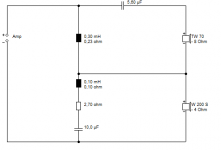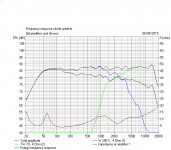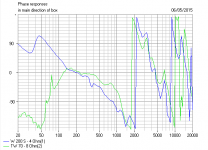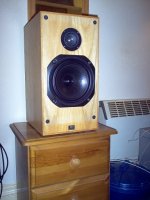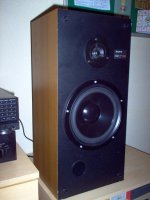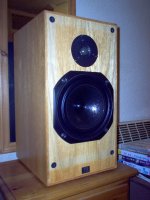why would the audio note arrangement could not make that driver sound dynamic?Of course you are right. After all the discussion regarding this dynamic thing, why is it still a mystery? 😕
Yes, we have semantic issue, because "dynamics" (as mentioned by anyone) means a few things. But for each of these "dynamics", the cause is very clear.
And for arrangement such as the Audionote, it cannot be "dynamic", NEVER! To improve upon it, first thing is to use waveguide. A waveguide can slow down, which means work against dynamics, but it can cure the main dynamic issue which common in small speakers.
And what will you suggest putting in that waveguide, Jay ?
That's a tough job, we both agree on that I believe. The lower the frequency, the harder it is to find one that close to perfect (we are talking about soft dome here, not compression drivers). When many others go lower than 2kHz, I have had a hard time just with 2k4!
From voice coil diameter or membrane area (some tweeters use "dual ring" such that even the coil is small the membrane is larger, but some have own issue) I think 1" is minimum.
From magnet strength (BL or simply the size of it), I prefer a strong one, preferably with "dual magnet". This is needed to push air through the waveguide without compromising dynamics too much.
From power handling perspective, it is not clear cut because power handling is usually related with compromise in the driver design. I will not look at lower than 100W continues, however. It doesn't have direct correlation tho. This may relate with moving mass (Mms) and ferro-fluid. So these 3 variables: high power handling (above 100W), no ferro-fluid, lower Mms (of the same type/brand), which is hard to find.
From dome material, I think there is one that is better than fabric but may have other compromises (HD for example).
why would the audio note arrangement could not make that driver sound dynamic?
From tweeter/HF perspective, you can see from my previous post.
Midbass cone material is preferably a stiff and lightweight one. It is very hard to work with but there is a reason why nowadays high-end manufacturers like Audionote do not go with 100% paper.
From enclosure type (which uses box resonance to "enhance" the sound), it is not really suitable for dynamics/transients.
Naturally, it is easy to find "dynamic" sound in 3-way than in 2-way speakers.
Last edited:
I think it is VERY INTERESTING that we have discovered that Audionote and Snell used 4 ohm bass drivers.
Audio Note Woofers | Hifi Collective
This is something new, to me at least. Of course the industry is quite fond of a 4 ohm bass in general. Seems to make for simpler crossovers.
Here's that relentlessly boring WLM La Scala speaker which plain fascinates me:
I have good reason to think that WLM are using the Visaton W200S-4 ohm driver along with that TW70 cone tweet. It looks shocking on paper, but give it a simple series filter, and I revise my opinion. Qms = 3.99 BTW with a rubber surround. Not 10, but high. Obviously no SEAS-type metal former there. 🙂
What an amazingly simple crossover that works at so many levels! The drivers are MADE for each other. 😎
Audio Note Woofers | Hifi Collective
This is something new, to me at least. Of course the industry is quite fond of a 4 ohm bass in general. Seems to make for simpler crossovers.
Here's that relentlessly boring WLM La Scala speaker which plain fascinates me:
An externally hosted image should be here but it was not working when we last tested it.
I have good reason to think that WLM are using the Visaton W200S-4 ohm driver along with that TW70 cone tweet. It looks shocking on paper, but give it a simple series filter, and I revise my opinion. Qms = 3.99 BTW with a rubber surround. Not 10, but high. Obviously no SEAS-type metal former there. 🙂
What an amazingly simple crossover that works at so many levels! The drivers are MADE for each other. 😎
Attachments
system7. I will repeat : Integration is everything. Similar cone/dome material makes this easier to get right. And the lower impedance is better for making simpler x-overs. Good , if your amp can handle it.
Waveguides have got easier to do with CAD, so theres no excuses for not trying. A good one of those, can make it fall into place.
I also think, that the tweeter dome, should be roughly the same shape and size, as the woofer dust cap. And that the tweter waveguide/faceplate should be the same size and shape, as the woofer cone. Maybe I think wrong.
I would say that in general implementation series crossovers sound less "dynamics" (whatever that mean) than parallel ones. And it relies heavily on "good luck". Very suitable for gamblers.
snup, you and I are possibly the few people who build speakers and then sit back and ask ourselves if it wins a cigar. 😀
Two ways are highly compromised in many respects. But I sure like my own two ways in terms of musicality. Mainly down to the cone tweeters. I'd be willing to spend some time on ring radiators like the XT25 in the near future though.
I don't see much wrong with metal tweeters too. But I don't greatly warm to plastic tweeters, and I detest soft domes.
Below, The GOOD, the BAD and the UGLY. In terms of tweeters. 😀
Two ways are highly compromised in many respects. But I sure like my own two ways in terms of musicality. Mainly down to the cone tweeters. I'd be willing to spend some time on ring radiators like the XT25 in the near future though.
I don't see much wrong with metal tweeters too. But I don't greatly warm to plastic tweeters, and I detest soft domes.
Below, The GOOD, the BAD and the UGLY. In terms of tweeters. 😀
Attachments
Experimentation is a gamble. If you can experiment the crossover away, like wesayso's towers, you are nearly home.
Waveguides have got easier to do with CAD, so theres no excuses for not trying. A good one of those, can make it fall into place.
After you get the right curvature and dimension, the implementation work will cause excuses.
I also think, that the tweeter dome, should be roughly the same shape and size, as the woofer dust cap. And that the tweter waveguide/faceplate should be the same size and shape, as the woofer cone. Maybe I think wrong.
Not really like that. But may be close. The idea is the relationship between frequency and wavelength. This, then, relates with what crossover frequency we are using and how the driver's response look like, etc.
A woofer dust cup is just a dust cap (to prevent dust from entering the gap). The center part (smaller diameter part of a circle) will produce HF if it is moving. With non-moving phase plug, the HF is produced solely by tweeter. But there is no reason that their size should be similar because the wavelength for common crossover frequency is well above 1".
This frequency-wavelength relationship is not only useful but is critical for designing waveguide and baffle, which is the last thing that will bother you when you want to achieve perfection.
And you can experiment all your life. Whats the excuse not to ?
If you are after the best sound or perfection, no excuse. But most people don't do thing like that. They move from one system to another, without bothering to improve down to detail.
The reason, I think the tweeterdome (if it is a dome), is that if the woofer dustcap moves with the woofers cone, they might radiate similarly. You can just vent from the back of the voicecoil chamber ofthe woofer. Why would you think a stationary dustcap would be an advantage ?
If the dustcap is part of the woofercone it adds area to the cone as well. Its a winwin gamble.
Yes, when the membrane/cone area is needed for lots of air movement (more bass) we need the extra area from dust cap. But we are working in midrange area, so lower extension can be achieved with other means, so we can focus on perfect midrange and highs with phase plug.
- Status
- Not open for further replies.
- Home
- Loudspeakers
- Multi-Way
- Discussion - What makes a speaker sound dynamic
